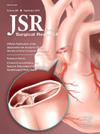外伤性脑损伤的部分:完全与部分血管内主动脉闭塞的力量
IF 1.7
3区 医学
Q2 SURGERY
引用次数: 0
摘要
复苏血管内球囊阻断主动脉是创伤性出血控制的辅助手段。许多需要主动脉闭塞的患者也伴有创伤性脑损伤(TBI)。创伤性脑损伤加上失血性休克是非常致命的。主动脉阻塞可使平均动脉压升高,从而使TBI患者的脑灌注压升高。低血压和生理上的高血压可增强创伤性脑损伤的继发性损伤。血管内主动脉闭塞(EAO)可以通过完全闭塞(FO)或部分闭塞(PO)来完成。PO允许滴定血压,而FO只能对血压有双重影响。关于FO和PO对TBI患者的影响的数据缺乏。因此,我们的目的是评估这两种方式与接受EAO的TBI患者预后的关系。方法:这是一项机构审查委员会批准的对美国创伤主动脉闭塞外科协会创伤和急性护理外科复苏登记的二次回顾性分析,包括所有简化损伤等级≥1并接受EAO的钝性创伤患者。我们将严重TBI定义为头部简易损伤量表。4. 我们比较了FO和PO。主要结局是EAO后收缩压(SBP)目标和死亡率。如果收缩压在>;90和<;EAO后5分钟内140mmhg。次要结局是住院时间、出院格拉斯哥昏迷量表(GCS)、出院格拉斯哥结局量表、性格、开颅率和并发症。结果147例患者纳入最终分析。其中97例行FO, 50例行PO。所有接受EAO的TBI患者的人口统计数据为年龄(40±18)、性别(32%女性)、损伤机制(93%钝性)、损伤严重程度评分(42±15)、入院收缩压(74±46 mmHg)和入院GCS(6±4)。两组在人口统计学上没有显著差异。接受PO的患者血小板输注量(5.3比2.5,P = 0.04)和晶体药物输注量(4比1.5,P = 0.003)显著减少。严重脑外伤患者行PO术比行FO术更能达到收缩压目标(57.1 vs 83, P = 0.019)。无论TBI严重程度如何,FO患者出现急性呼吸窘迫综合征的比例较高。EAO组在住院时间、死亡率、出院GCS、出院格拉斯哥结局量表、处置或开颅率方面没有显著差异。结论spo能更好地测定收缩压,从而减少脑外伤的继发损伤。PO与较低的急性呼吸窘迫综合征发生率相关。然而,EAO类型与TBI患者的生存差异无关。本文章由计算机程序翻译,如有差异,请以英文原文为准。
The Power of Partial: Full versus Partial Endovascular Aortic Occlusion in Traumatic Brain Injury
Introduction
Resuscitative endovascular balloon occlusion of the aorta is an adjunct for hemorrhage control in trauma. Many patients requiring aortic occlusion also have concomitant traumatic brain injury (TBI). The combination of TBI and hemorrhagic shock is highly lethal. Aortic occlusion can increase mean arterial pressure, thus augmenting cerebral perfusion pressure in TBI patients. Hypotension and supraphysiologic hypertension can potentiate secondary insults in TBI. Endovascular aortic occlusion (EAO) can be done with full occlusion (FO) or partial occlusion (PO). PO allows for the titration of blood pressure, whereas FO can only have a binary effect on blood pressure. There is a paucity of data on the effects of FO and PO in patients with TBI. Therefore, we aim to evaluate the association of these two modalities with outcomes in TBI patients undergoing EAO.
Methods
This was an institutional review board–approved secondary retrospective analysis of the American Association for the Surgery of Trauma Aortic Occlusion for Resuscitation in Trauma and Acute Care Surgery registry that included all blunt trauma patients with Abbreviated Injury Scale head ≥ 1 and underwent EAO. We define severe TBI as head Abbreviated Injury Scale > 4. We compared FO and PO. Primary outcomes were systolic blood pressure (SBP) goal after EAO and mortality. Patients were considered to have SBP at goal if it was between > 90 and < 140 mmHg within 5 minutes after EAO. Secondary outcomes were length of stay, discharge Glasgow Coma Scale (GCS), discharge Glasgow Outcome Scale, disposition, rates of craniectomy, and complications.
Results
147 patients were included in the final analysis. Of these, 97 underwent FO and 50 underwent PO. Demographics for all TBI patients undergoing EAO were age (40 ± 18), sex (32% female), mechanism of injury (93% blunt), injury severity score (42 ± 15), admission SBP (74 ± 46 mmHg), and admission GCS (6 ± 4). There was no significant difference in demographics between the two groups. Patients undergoing PO had significantly decreased transfusion of platelets (5.3 versus 2.5, P = 0.04) and administration of crystalloids (4 versus 1.5, P = 0.003). Patients with severe TBI who underwent PO met SBP goal significantly more often than patients who underwent FO (57.1 versus 83, P = 0.019). Higher rates of acute respiratory distress syndrome were seen in patients who underwent FO regardless of TBI severity. There was no significant difference in length of stay, mortality, discharge GCS, discharge Glasgow Outcome Scale, disposition, or rates of craniectomy between EAO groups.
Conclusions
PO enables better SBP titration and thereby can minimize secondary insult in TBI. PO is associated with lower rates of acute respiratory distress syndrome. EAO type, however, is not associated with differences in survival in TBI patients.
求助全文
通过发布文献求助,成功后即可免费获取论文全文。
去求助
来源期刊
CiteScore
3.90
自引率
4.50%
发文量
627
审稿时长
138 days
期刊介绍:
The Journal of Surgical Research: Clinical and Laboratory Investigation publishes original articles concerned with clinical and laboratory investigations relevant to surgical practice and teaching. The journal emphasizes reports of clinical investigations or fundamental research bearing directly on surgical management that will be of general interest to a broad range of surgeons and surgical researchers. The articles presented need not have been the products of surgeons or of surgical laboratories.
The Journal of Surgical Research also features review articles and special articles relating to educational, research, or social issues of interest to the academic surgical community.

 求助内容:
求助内容: 应助结果提醒方式:
应助结果提醒方式:


